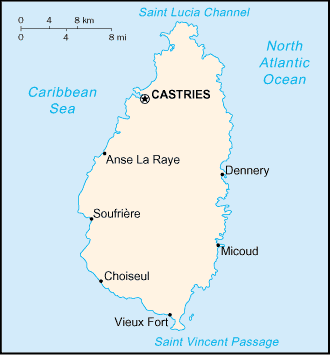Geography of Saint Lucia
|
|
Saint_Lucia.png
Location: Caribbean, island between the Caribbean Sea and North Atlantic Ocean, north of Trinidad and Tobago.
Geographic coordinates: Template:Coor dm
Map references: Central America and the Caribbean
Area:
total:
620 km²
land:
610 km²
water:
10 km²
Area - comparative: 3.5 times the size of Washington, DC
Land boundaries: 0 km
Coastline: 158 km
Maritime claims:
200 nautical miles (370 km)
contiguous zone:
24 nautical miles (44 km)
exclusive economic zone:
200 nautical miles (370 km)
territorial sea:
12 nautical miles (22 km)
Climate: tropical, moderated by northeast trade winds; dry season from January to April, rainy season from May to August
Terrain: volcanic and mountainous with some broad, fertile valleys
Elevation extremes:
lowest point:
Caribbean Sea 0 m
highest point:
Mount Gimie 950 m
|
Missing image |
Natural resources: forests, sandy beaches, minerals (pumice), mineral springs, geothermal potential
Land use:
arable land:
8%
permanent crops:
21%
permanent pastures:
5%
forests and woodland:
13%
other:
53% (1993 est.)
Irrigated land: 10 km² (1993 est.)
Natural hazards: hurricanes and volcanic activity
Environment - current issues: deforestation; soil erosion, particularly in the northern region
Environment - international agreements:
party to:
Biodiversity, Climate Change,Desertification,Endangered Species,Environmental Modification,Hazardous Wastes,Law of the Sea,Marine Dumping,Ozone Layer Protection,Whaling,
signed, but not ratified:
Climate Change-Kyoto Protocol
- See also : Saint Luciaes:Geografía de Santa Lucía

